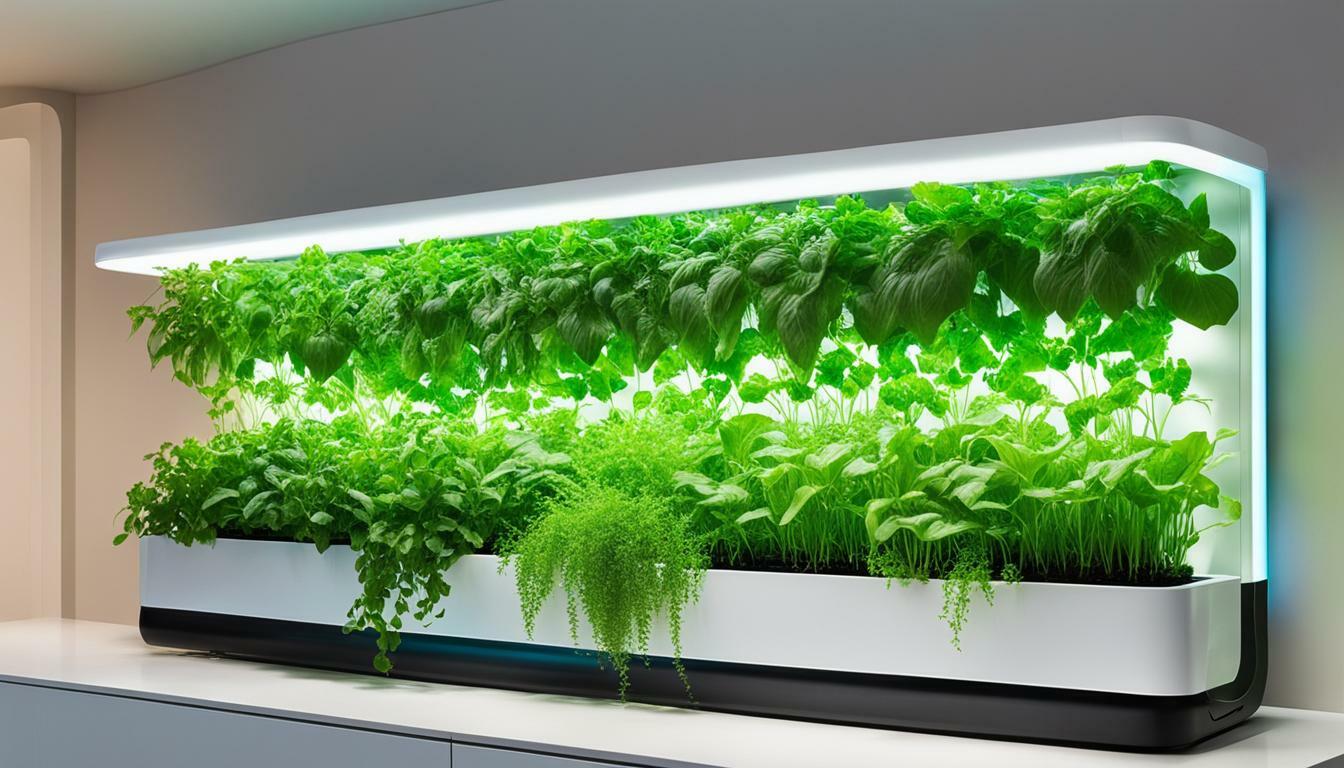Key Takeaways:
- Hydroponic vertical gardening is a space-saving and efficient way to grow plants in urban environments.
- Vertical hydroponic systems utilize vertical space and maximize plant growth in a small area.
- Benefits of vertical hydroponics include reduced pesticide use, increased growth rate, efficient water consumption, improved yield, and better environmental sustainability.
- Limitations of vertical hydroponics include system complexity, higher initial cost, pest and disease risks, and maintenance requirements.
- Starting your own vertical hydroponic system requires careful planning and selection of the right equipment.
- Success in vertical hydroponic gardening can be achieved by selecting the right plants, managing light and water, and maintaining the system properly.
- The future of vertical hydroponics holds great potential in sustainable agriculture and urban farming.
Understanding Hydroponics and Vertical Hydroponic Systems
Hydroponics is a soil-less method of gardening that has gained popularity in recent years, offering a space-saving solution for both indoor and outdoor vertical gardening. With hydroponics, plants are grown in a nutrient-rich water solution instead of soil, allowing for faster growth and increased yields.
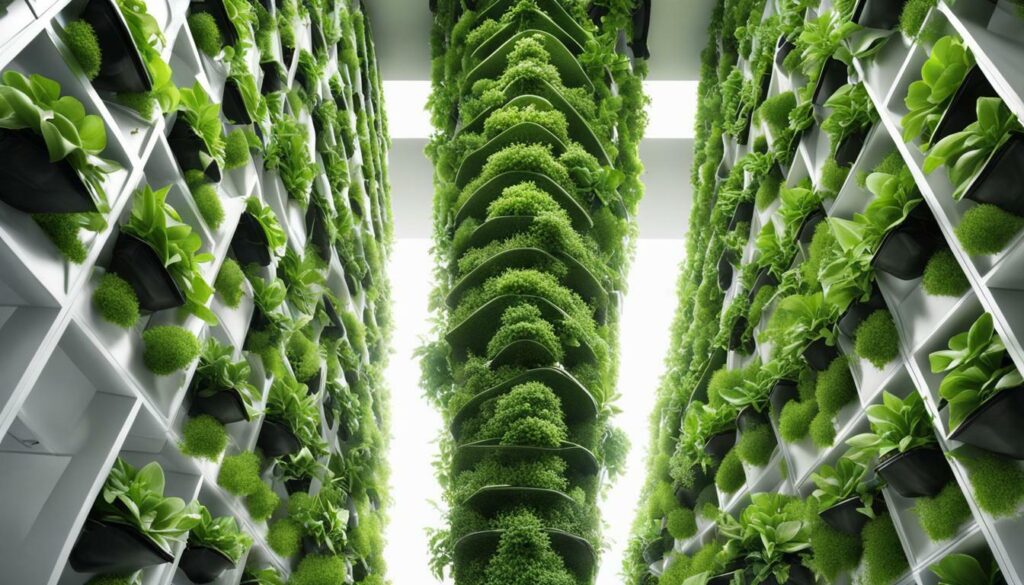
In traditional soil-based gardening, plants rely on soil to anchor their roots and absorb moisture and nutrients. In hydroponics, the roots are suspended in a nutrient-rich water solution, providing plants with direct access to the essential elements they need for growth.
Vertical hydroponic systems take this concept a step further by utilizing vertical space rather than horizontal space. Plants are grown in vertically stacked planters or tubes, maximizing the use of limited space. This makes vertical hydroponics ideal for urban gardening, where space is often limited.
The Advantages of Vertical Hydroponics
Vertical hydroponics offers several advantages over traditional gardening methods. Firstly, it allows for high-density yield per unit area, making it an efficient way to grow a large number of plants in a small space. This is especially beneficial for urban areas where land is scarce.
Additionally, vertical hydroponics is great for small sunny spaces like balconies, patios, and rooftops. It provides an opportunity to grow fresh produce year-round, regardless of outdoor weather conditions.
Vertical hydroponic systems are also highly efficient in water use. They typically require up to 80% less water compared to traditional soil-based gardening, as water is recirculated within the system rather than being lost to evaporation or runoff.
Furthermore, vertical hydroponics eliminates the risk of soil-borne diseases, as plants are not in direct contact with soil. This reduces the need for pesticides and fungicides, making it a healthier and more sustainable gardening option.
Table: Advantages of Vertical Hydroponics
| Advantage | Description |
|---|---|
| Space Savings | Maximizes limited space, ideal for urban gardening |
| Lack of Soil | Eliminates soil-borne diseases and reduces the need for chemicals |
| Efficiency & Productivity | Optimizes nutrient delivery for faster growth and increased yields |
| Low Maintenance | Water-efficient and requires minimal upkeep |
In conclusion, hydroponics and vertical hydroponic systems offer a modern and efficient approach to gardening. They provide a space-saving solution for both indoor and outdoor cultivation, allowing for year-round production, increased efficiency, and improved water usage.
Advantages of Vertical Hydroponics
Vertical hydroponics offers numerous advantages for those with limited space, allowing you to create a stunning vertical garden design even in small areas. With this innovative gardening method, plants are grown in vertically stacked planters, maximizing space and providing a range of benefits.
Space Savings
One of the biggest advantages of vertical hydroponics is its space-saving design. Traditional gardening methods require ample floor space, which can be a challenge in urban environments or homes with limited outdoor areas. Vertical hydroponics allows you to optimize vertical space by growing plants upwards rather than outwards. This makes it perfect for balconies, patios, rooftops, or even indoor areas where floor space is limited. By utilizing vertical space effectively, you can grow a large number of plants in a small area, maximizing your yield and making the most of your available space.
Furthermore, hydroponic systems do not require soil, which means there is no need for large planting beds or garden plots. The plants are grown in nutrient-rich water solutions, eliminating the need for traditional soil-based gardening. This not only saves space but also reduces the risk of soil-borne diseases and pests, providing a cleaner and healthier gardening environment.
Efficiency & Productivity
Vertical hydroponics offers unparalleled efficiency and productivity compared to traditional gardening methods. By delivering water and nutrients directly to the plant’s roots, hydroponic systems ensure optimal growth and nutrient absorption. The controlled environment in vertical hydroponics systems allows for precise temperature, lighting, and air composition control, resulting in faster growth rates, higher quality produce, and increased yield.
Additionally, vertical hydroponics allows for maximum plant density per unit area. With plants grown closely together in vertically stacked planters, there is no wasted space. The compact layout of vertical hydroponics systems enables growers to maximize their crop production capacity, making it an ideal choice for commercial growers who need to produce large quantities of plants efficiently and quickly.
Low Maintenance
Vertical hydroponics systems are designed to be low maintenance, making them a convenient option for both beginners and experienced gardeners. The closed-loop water recirculation system in hydroponics minimizes water wastage, conserving up to 80% of water compared to traditional soil-based gardening. The recirculating system also reduces the need for frequent watering, as water is continually reused within the system.
Furthermore, the controlled environment in vertical hydroponics systems significantly reduces the risk of weeds, pests, and plant diseases. Without soil, there are fewer opportunities for weeds to take root and fewer hiding places for pests. This translates to reduced chemical pesticide use, making vertical hydroponics a more sustainable and environmentally friendly gardening option.
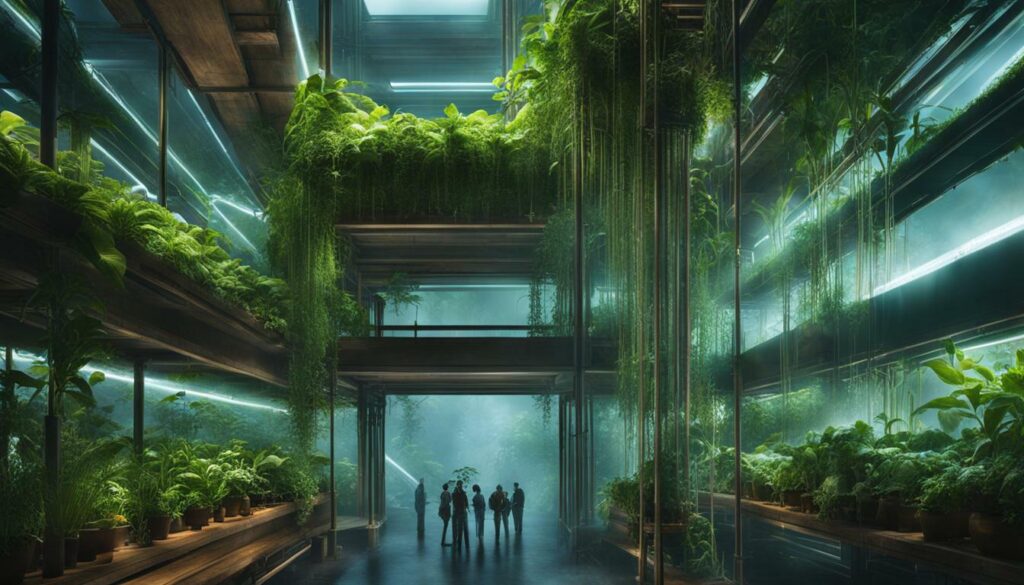
| Advantages of Vertical Hydroponics |
|---|
| Space Savings |
| Efficiency & Productivity |
| Low Maintenance |
Increased Efficiency and Yield with Vertical Hydroponics
Vertical hydroponic systems provide an efficient and effective way to grow plants, resulting in increased yield compared to traditional gardening methods. By utilizing vertical space, these systems maximize plant growth potential and optimize the use of available space.
One advantage of vertical hydroponics is the ability to produce a large number of plants in a small area. This is especially beneficial for urban spaces where land is limited. Vertical hydroponic systems allow growers to stack planters vertically, effectively utilizing unused vertical space.
With vertical hydroponics, plants are grown in vertically stacked planters that contain a nutrient-rich water solution. The solution is either supplied from the top and flows down to the bottom planters, or it recirculates through the system. This constant supply of nutrients ensures that plants receive the necessary elements for healthy growth, resulting in faster growth rates and larger yields.
| Advantages of Vertical Hydroponics |
|---|
| Space Savings |
| No Soil-Borne Diseases |
| Increased Efficiency |
| Reduced Water Consumption |
| Better Nutrient Control |
| Improved Yield |
Vertical hydroponics also allows for better nutrient control. Growers can precisely monitor and adjust the nutrient solution, ensuring that plants receive the ideal balance of essential elements for optimal growth. This eliminates the guesswork and variability associated with traditional soil-based gardening.
Furthermore, vertical hydroponic systems require less water compared to traditional gardening methods. The recirculating nature of the systems allows for water conservation, as the water is not lost to evaporation or runoff. This makes vertical hydroponics a more sustainable and environmentally friendly option.
Overall, vertical hydroponics offers numerous advantages, including increased efficiency, better nutrient control, reduced water consumption, and improved yield. While there are some limitations and maintenance requirements associated with these systems, the benefits outweigh the challenges for many growers.
The Science Behind Vertical Hydroponics
In vertical hydroponics, plants’ roots are suspended in a nutrient-rich water solution, allowing for direct uptake of essential nutrients. The roots are anchored in perforated grow media, such as Rockwool or coco coir, which provide support and allow for proper nutrient absorption.
The water solution is typically pumped from a reservoir to the top planter in the system and then flows down through the remaining planters. As the water flows, it picks up oxygen, ensuring the roots have an adequate oxygen supply. This oxygenation is crucial for plant growth and helps promote healthy root development.
The combination of nutrient-rich water, oxygenation, and controlled environment in vertical hydroponics creates the ideal conditions for plants to thrive. This optimized growing environment allows for increased efficiency and improved yield compared to traditional gardening methods.
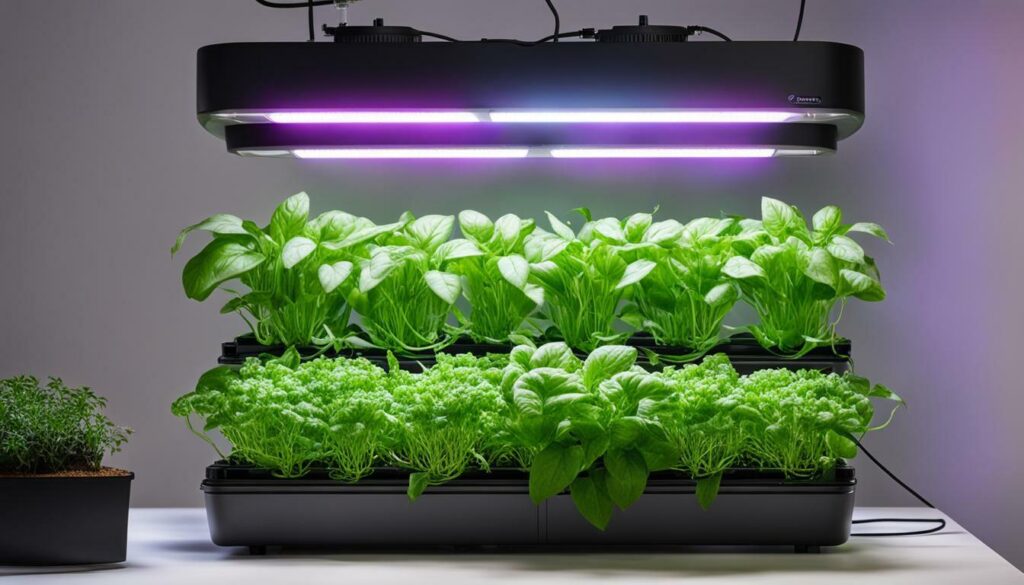
“Vertical hydroponic systems provide an efficient and effective way to grow plants, resulting in increased yield compared to traditional gardening methods.”
– Source: Hardeep Singh, Bruce Dunn
The Science Behind Vertical Hydroponics
In vertical hydroponics, plants are anchored in a nutrient-rich water solution, allowing their roots to receive essential oxygen and nutrients for optimal growth. Unlike traditional gardening methods that rely on soil, vertical hydroponics utilizes a different approach to support plant growth. The roots of plants in a vertical hydroponic system are anchored in perforated grow media such as Rockwool, sponge, oasis cube, or coco coir. These grow media allow the roots to come into contact with the nutrient-rich water solution, which provides the necessary nutrients for plant growth.
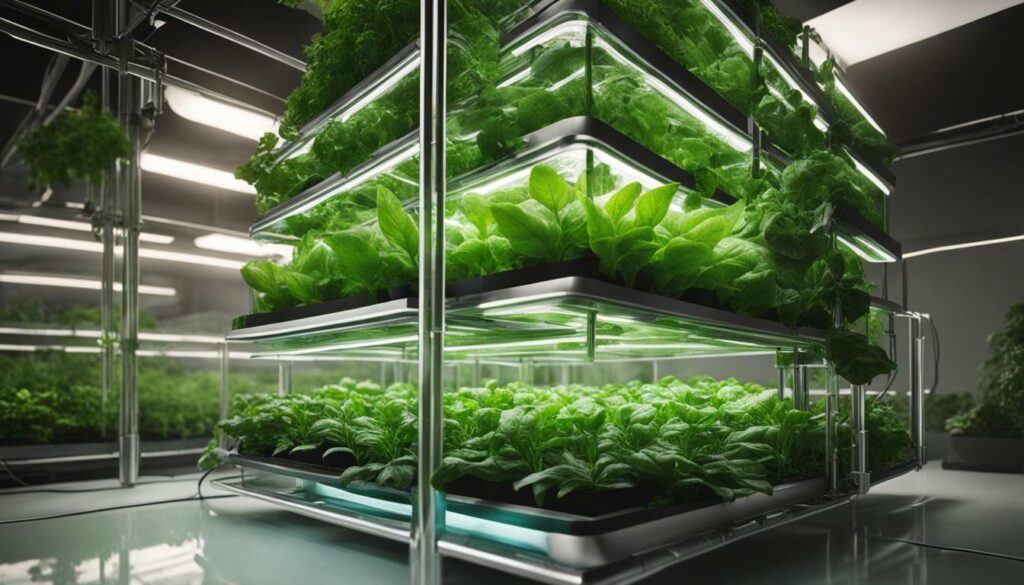
The water solution, often referred to as the nutrient solution, is typically pumped from a reservoir and distributed to the top planter in the vertical hydroponic system. From there, the water solution flows down through each planter, providing the necessary nutrients to the plants’ roots along the way. As the water flows, it picks up oxygen, which is crucial for the roots’ health and growth. Oxygenation of the roots is essential for the absorption of nutrients and overall plant development.
Vertical hydroponics offers various advantages over traditional gardening methods. The controlled environment allows for efficient nutrient delivery, ensuring that plants receive precisely what they need for optimal growth and productivity. The absence of soil also eliminates the risk of soil-borne diseases and pests, reducing the need for harmful pesticides and herbicides. Additionally, vertical hydroponics utilizes water more efficiently, making it a sustainable option with reduced water consumption compared to traditional gardening methods.
The Benefits of Vertical Hydroponics:
- Reduced need for pesticides: Vertical hydroponics minimizes the risk of pests and diseases by eliminating soil contact, reducing the need for chemical pest control.
- Increased growth rate: Plants grown in vertical hydroponic systems experience faster growth rates due to constant access to oxygen, moisture, and nutrients.
- Nutrient control: Vertical hydroponics allows precise control over nutrient delivery, ensuring that plants receive the optimal balance of nutrients.
- Less water consumption: Vertical hydroponic systems use significantly less water compared to traditional gardening methods, conserving this valuable resource.
- Improved yield: The controlled environment of vertical hydroponics allows for larger and more productive yields compared to soil-based gardening.
- Increased efficiency: Vertical hydroponic systems maximize space utilization, enabling growers to produce more plants in a smaller area. Automation options also improve efficiency and reduce labor costs.
- Better for the environment: Vertical hydroponics eliminates the need for harmful chemicals and reduces water consumption, making it an environmentally friendly choice for sustainable agriculture.
While vertical hydroponics offers numerous advantages, it’s essential to consider the limitations. Vertical hydroponic systems can be complex and require regular maintenance to ensure optimal performance. Upfront costs may be higher compared to traditional gardening methods, and pest and disease issues can be magnified in densely planted vertical setups. However, with proper knowledge and maintenance, vertical hydroponics can provide a space-saving, efficient, and sustainable method for cultivating plants, making it an appealing option for both commercial growers and urban gardeners.
Benefits of Vertical Hydroponics
Vertical hydroponics offers a range of benefits for gardeners, including reduced reliance on pesticides, faster plant growth, and improved water efficiency. With traditional soil gardening, pests and diseases can easily hitchhike into the garden through contaminated soil, leading to the need for pesticides. However, in vertical hydroponics, where plants are grown without soil, the risk of soil-borne pests and diseases is greatly reduced. This means that growers can significantly reduce their use of pesticides, making it a healthier and more environmentally friendly option.
Another advantage of vertical hydroponics is the faster growth rate of plants. In a vertical hydroponic system, plants have constant access to oxygen, moisture, and nutrients, allowing them to grow 20-25% faster than plants grown in soil. The controlled environment of a vertical hydroponic system ensures that plants receive the optimal amount of nutrients at the right times, resulting in accelerated growth and higher yields.
Vertical hydroponics is also a water-efficient gardening method. Hydroponic gardens use up to 10% of the water used in traditional soil gardens because there is no water lost to evaporation or runoff. In addition, vertical hydroponic systems recirculate water between grow trays, further reducing water consumption. This makes vertical hydroponics not only better for the environment but also helps save money on water bills in the long run.
One of the key benefits of vertical hydroponics is the improved yield it offers. With continuous access to nutrients and a controlled environment, plants grown using hydroponics produce larger yields compared to traditional soil gardening. This can be especially advantageous for commercial growers who need to produce large quantities of plants efficiently and quickly.
| Benefits of Vertical Hydroponics |
|---|
| Reduced reliance on pesticides |
| Faster plant growth |
| Improved water efficiency |
| Increased yield |
In addition to these benefits, vertical hydroponics offers increased efficiency compared to traditional gardening methods. By utilizing vertical space, growers can produce more plants in the same area or the same number of plants in less space. The ability to automate vertical hydroponic systems also saves time and labor costs in the long run. Furthermore, vertical hydroponics is better for the environment as it eliminates the need for soil tilling and reduces the use of harmful chemicals. It provides a sustainable and eco-friendly way to grow food.
While vertical hydroponics has numerous advantages, it is important to be aware of the limitations. Vertical hydroponic systems can be complex to set up and maintain, with higher initial costs compared to traditional soil gardens. Additionally, the close proximity of plants in a vertical system can increase the risk of pest and disease issues if not properly monitored. Regular maintenance and inspection are necessary to ensure the system functions optimally.
To successfully start your own vertical hydroponic system, it is essential to choose the right equipment and set up the system correctly. Research and select a reputable supplier who can provide all the necessary components for your vertical hydroponics endeavor. Additionally, implementing expert tips such as selecting the right plants, managing light and water, and maintaining the system can contribute to successful vertical hydroponic gardening.
Looking forward, vertical hydroponics holds great potential for the future of gardening. Its space-saving design, increased efficiency, and environmentally friendly nature make it an excellent option for urban farming and sustainable agriculture. As more people recognize the benefits of vertical hydroponics, it is expected to become an integral part of the gardening landscape.
Quote:
“Vertical hydroponics offers a sustainable and efficient way to grow plants, maximizing space and resources while minimizing the use of pesticides and water.”
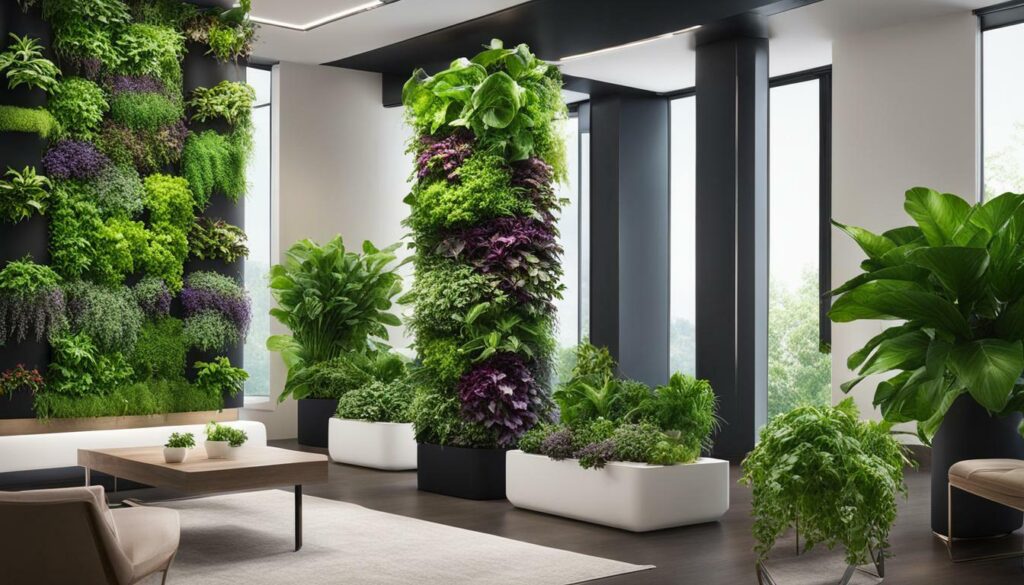
Image: Vertical hydroponics
Limitations of Vertical Hydroponics
While vertical hydroponics offers many advantages, it’s important to consider the challenges such as system complexity, higher initial cost, and pest and disease management.
One of the major disadvantages of vertical hydroponics is the complexity of the systems. There are many moving parts involved, and if one thing goes wrong, it can disrupt the entire system. This complexity also makes vertical hydroponic systems more expensive to set up compared to traditional soil gardens. However, the increased yields and space-saving benefits often make up for the higher upfront cost.
Pest and disease issues can also be magnified in vertical hydroponics systems. With plants grown closely together, pests and diseases can spread quickly and cause significant damage. It’s crucial to regularly inspect and monitor the plants for any signs of pests or diseases and take immediate action to prevent further infestation.
Maintenance requirements are another consideration with vertical hydroponics. These systems require regular inspection and cleaning of the moving parts, as well as regular changes of the nutrient solution. Neglecting maintenance can lead to overcrowding and inefficient plant growth.
Table: Pros and Cons of Vertical Hydroponics
| Advantages | Disadvantages |
|---|---|
| – Space-saving design | – System complexity |
| – Versatility in small spaces | – Higher initial cost |
| – Increased growth rate | – Pest and disease issues |
| – Nutrient control | – Maintenance requirements |
| – Reduced need for pesticides | |
| – Less water consumption | |
| – Improved yield | |
| – Increased efficiency | |
| – Better for the environment |
While these limitations should be taken into account, vertical hydroponics still offers many benefits and can be a great way to grow plants in small spaces and achieve high yields. With proper planning, maintenance, and attention to pest and disease control, vertical hydroponic systems can thrive and provide a sustainable and efficient gardening solution.
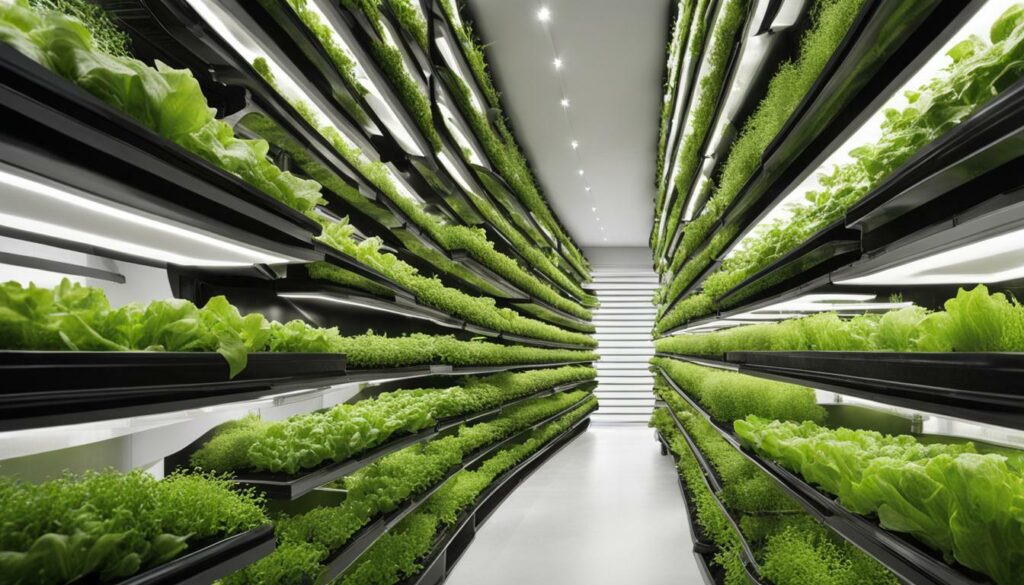
Starting Your Own Vertical Hydroponic System
Ready to start your own hydroponic vertical garden? Here’s a step-by-step guide to help you get started with vertical hydroponics.
Step 1: Choose the Right Equipment
The first step in setting up your vertical hydroponic system is to choose the right equipment. This includes selecting a vertical garden system that suits your space and needs. There are various options available, from DIY vertical hydroponic systems to pre-made kits.
Consider the size of your space and the number of plants you want to grow. Look for a system that offers adjustable tiers or shelves, allowing you to accommodate plants of different sizes. You’ll also need to invest in a nutrient solution specifically designed for hydroponic gardening, as well as grow lights if you plan to grow indoors.
Step 2: Set Up the System
Once you have your equipment, it’s time to set up your vertical hydroponic system. Start by assembling the vertical garden according to the manufacturer’s instructions. Make sure the system is stable and secure, as it will be supporting the weight of the plants and the nutrient solution.
Next, prepare your nutrient solution and fill the reservoir of the vertical garden system. Follow the recommended ratios for mixing the nutrients, as different plants have different nutrient requirements. It’s important to monitor the pH levels of the nutrient solution regularly and make adjustments as needed.
Step 3: Choose the Right Plants
Choose plants that are suitable for vertical hydroponic gardening. Leafy greens, herbs, and small fruiting plants like strawberries are excellent choices. Avoid plants with large root systems or vigorous growth habits, as they may outgrow the vertical space quickly.
Consider the lighting requirements of the plants you choose. If you’re growing indoors, make sure you provide adequate artificial lighting to support plant growth. Position the grow lights at the appropriate distance from the plants to ensure optimal light absorption.
Step 4: Maintain and Monitor
Regular maintenance and monitoring are crucial for the success of your vertical hydroponic system. Check the nutrient levels and pH of the solution regularly, and top up or adjust as needed. Inspect the plants for signs of pests or diseases and take appropriate action if necessary.
Monitor the water levels in the reservoir and make sure the system is running smoothly. Keep an eye on the plants’ growth and adjust the positioning of the shelves or tiers if needed to ensure equal access to light.
Remember to follow the instructions provided by the manufacturer and consult reliable resources for specific guidance on caring for your chosen plants in a vertical hydroponic system.
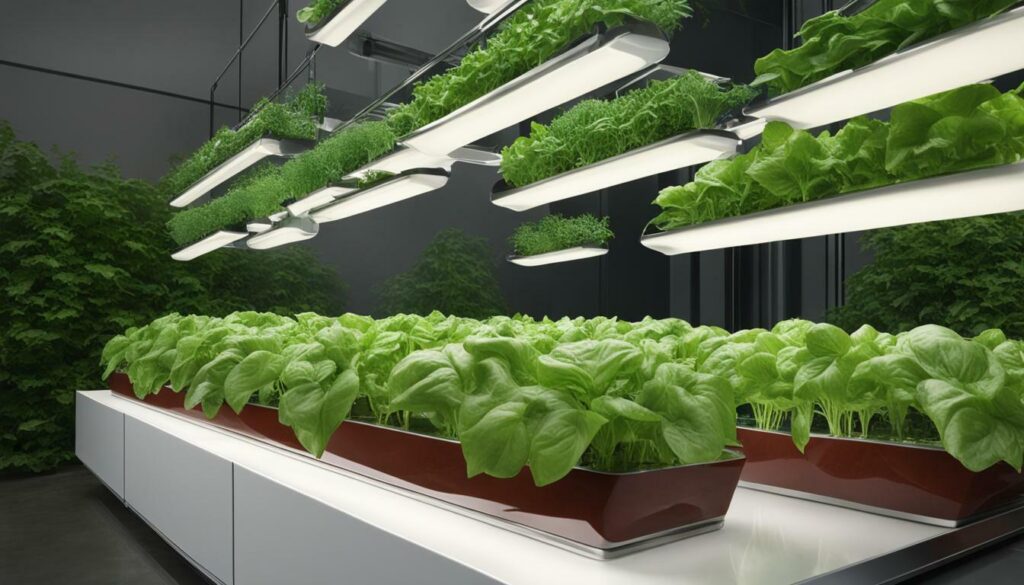
| Advantages of Vertical Hydroponics | Disadvantages of Vertical Hydroponics |
|---|---|
|
|
“Vertical hydroponics is a godsend for people who don’t have access to much soil or ground space to grow things.”
As you can see, starting your own vertical hydroponic system offers many advantages, such as space savings, efficient use of resources, and minimal maintenance. However, it’s essential to be aware of the potential challenges, such as water flow and lighting requirements.
By following the steps outlined above and addressing these challenges, you can enjoy the benefits of growing your own fresh produce in a vertical hydroponic garden. Happy gardening!
Tips for Successful Vertical Hydroponic Gardening
To ensure success with your hydroponic vertical garden, follow these expert tips and tricks for optimal plant growth and maintenance.
1. Choose the Right Plants
Selecting the right plants is crucial for successful vertical hydroponic gardening. Opt for crops that have shallow root systems and can thrive in a nutrient-rich water solution. Some ideal choices for vertical hydroponics include lettuce, spinach, herbs, strawberries, and cherry tomatoes. These plants are well-suited for vertical systems and have high yields.
2. Manage Light and Water
Proper lighting and watering are essential for the health and growth of your plants. Position your vertical hydroponic system in a location that receives adequate sunlight or invest in high-quality grow lights for indoor setups. Ensure that each level of your vertical garden receives equal amounts of light by arranging light panels accordingly.
When it comes to watering, maintain a consistent schedule and avoid overwatering. Monitor the moisture levels in your growing media or water solution to prevent waterlogging, which can lead to root rot. Use a timer to automate the watering process and ensure that each plant receives the right amount of hydration.
3. Maintain the System
Regular maintenance is essential to keep your vertical hydroponic system functioning optimally. Check the pH and nutrient levels of your water solution regularly and make necessary adjustments to ensure the nutrient balance is appropriate for your plants. Clean and sanitize your system regularly to prevent the buildup of algae, bacteria, or pests. Inspect all components, including pumps, pipes, and fittings, for any signs of wear or damage and replace them as needed.
Additionally, pruning and trimming your plants regularly will promote healthy growth and prevent overgrowth or shading of lower levels. Remove any dead or diseased leaves promptly to avoid the spread of pests or diseases within the system.
Remember, successful vertical hydroponic gardening requires attention to detail and regular monitoring. By following these tips, you can create a thriving vertical garden and enjoy a bountiful harvest of fresh, homegrown produce.
| Advantages of Vertical Hydroponics | |
|---|---|
| Space Savings | |
| – Allows for high density yield per unit area. | – Good for small sunny places like balconies, patios, and rooftops. |
| Lack of Soil | |
| – No soil-borne diseases. | – Minimized use of chemical fertilizers, fungicides, and pesticides. |
| Efficiency & Productivity | |
| – Optimal nutrient delivery for faster growth and maximum yield. | – Controlled environment for year-round production. |
| Low Maintenance | |
| – Water conservation and reduced water usage. | – Minimal wastage in a closed-loop system. |

The Future of Vertical Hydroponics
Vertical hydroponics holds great promise for the future of agriculture, with the potential for sustainable food production in urban areas and advancements in vertical farming systems. As the world grapples with limited arable land, water scarcity, and the need for more efficient and environmentally friendly farming methods, vertical hydroponics offers a solution that maximizes space and resources while providing high-yield crops.
With vertical hydroponics, plants are grown in vertically stacked planters or towers that utilize minimal space and maximize plant growth. This method allows for high-density yield per unit area and is particularly well-suited for small sunny places like balconies, patios, and rooftops. Vertical hydroponics also enables year-round production indoors, making it ideal for urban dwellers who may not have access to traditional gardening spaces.
One of the key advantages of vertical hydroponics is its ability to optimize resource efficiency. By using a closed-loop system that recirculates water and nutrients, vertical hydroponics can conserve up to 80% of water compared to traditional soil-based gardening. Additionally, the controlled environment of vertical hydroponics systems allows for precise nutrient delivery, resulting in faster growth rates, improved crop quality, and increased yield.
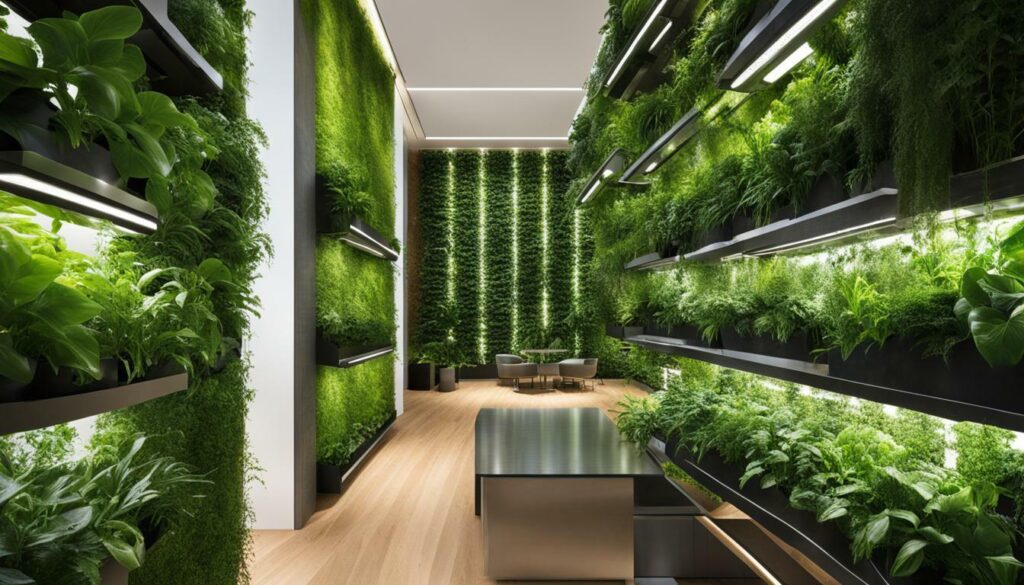
Vertical hydroponics also offers numerous environmental benefits. By eliminating the need for soil and minimizing pesticide and fertilizer use, it reduces the risk of soil erosion, water pollution, and the loss of biodiversity. The controlled environment and reduced water consumption of vertical hydroponics make it a more sustainable and eco-friendly farming method compared to traditional agriculture.
While vertical hydroponics presents many advantages, there are also challenges to overcome. The delivery of water, nutrients, and light to plants on all levels of a vertical system requires careful planning and the use of efficient pumps and lighting systems. Additionally, vertical hydroponics systems can be more complex and expensive to set up compared to traditional gardening. However, the potential benefits, including higher yields, reduced resource consumption, and increased food security, make vertical hydroponics a compelling option for the future of agriculture.
Advancements in Vertical Farming
As technology continues to evolve, so does the potential for advancements in vertical farming. Innovations in LED lighting, automation, and data analytics are revolutionizing the way vertical hydroponics is practiced. LED lights are becoming more energy-efficient and cost-effective, making indoor vertical farming more economically viable. Automation systems can monitor and control environmental factors such as temperature, humidity, and nutrient levels, optimizing plant growth and reducing labor requirements. Data analytics enable growers to track and analyze plant performance, leading to continuous improvements in crop yield and quality.
The future of vertical hydroponics also includes the development of larger-scale commercial vertical farms that can supply fresh produce on a larger scale, reducing the need for long-distance transportation and minimizing food waste. Integrating vertical farming systems with renewable energy sources and sustainable practices can further enhance the environmental benefits and long-term viability of vertical hydroponics.
| Advantages of Vertical Hydroponics | Disadvantages of Vertical Hydroponics |
|---|---|
|
|
In conclusion, vertical hydroponics has the potential to revolutionize agriculture and address the challenges of limited space, water scarcity, and the need for sustainable food production. By maximizing resource efficiency, reducing environmental impact, and enabling year-round crop production, vertical hydroponics offers a promising future for urban farming and the advancement of agriculture as a whole.
Conclusion
In conclusion, a hydroponic vertical garden offers the perfect solution for high-yield growth in urban spaces, providing a sustainable and efficient way to grow a variety of plants. With the ability to maximize space and utilize verticality, hydroponic vertical gardening is ideal for beginners and experienced gardeners alike.
Vertical hydroponic systems allow for year-round gardening in any season, making it the future of gardening in urban areas. By understanding the concept of hydroponics and vertical hydroponic systems, you can take advantage of the benefits they provide.
Not only does vertical hydroponics save space, but it also offers increased efficiency and improved yield. The controlled environment and nutrient-rich water solutions result in faster growth rates and larger yields compared to traditional soil gardening.
Furthermore, vertical hydroponic systems have numerous benefits, such as reduced need for pesticides, improved nutrient control, less water consumption, and better environmental sustainability. By opting for vertical hydroponics, you can grow your own fresh and healthy produce while minimizing your impact on the environment.
While there are some limitations, such as system complexity and higher initial costs, the benefits greatly outweigh the challenges. With proper maintenance and attention to detail, you can successfully start and maintain your own vertical hydroponic system.
Vertical hydroponics is not just a trend; it is the future of gardening. As sustainable agriculture becomes increasingly important, vertical hydroponic systems will play a crucial role in feeding growing populations and promoting food security.
So whether you’re a beginner looking to start your own urban garden or a seasoned gardener seeking to maximize your yield, consider incorporating a hydroponic vertical garden into your gardening repertoire. Experience the high-yield growth and reap the rewards of this innovative and efficient gardening method.
What are the benefits of a vertical hydroponic garden compared to traditional gardening methods for high-yield growth?
A superior vertical hydroponic garden offers numerous benefits over traditional gardening methods for high-yield growth. The controlled environment allows for optimal nutrient delivery, water conservation, and space efficiency. With vertical gardening, plants grow faster and healthier, resulting in increased productivity and higher yields.
Can the Techniques Used in a Strawberry Vertical Garden be Applied to a Hydroponic Vertical Garden for High-Yield Growth?
Yes, the techniques used in a strawberry vertical garden can be applied to a hydroponic vertical garden for high-yield growth. By utilizing the same principles of vertical gardening and optimizing nutrient delivery, hydroponic systems can achieve impressive strawberry vertical garden yield results.
FAQ
Q: What is vertical hydroponics?
A: Vertical hydroponics is a method of growing plants without soil in a vertical fashion, where mineral nutrients are provided through water. It utilizes vertical space rather than horizontal space, allowing for high-density yield per unit area.
Q: What are the advantages of vertical hydroponics?
A: Vertical hydroponics offers space-saving solutions for urban gardening, allows for year-round production indoors, minimizes soil-borne diseases, conserves water usage, increases efficiency and productivity, and is low-maintenance.
Q: How does vertical hydroponics improve plant growth and yield?
A: Vertical hydroponics optimizes plant growth by providing plants with the right quantity of nutrients at the right times. The controlled environment in hydroponic systems allows for better temperature, light, air composition, and pest control, resulting in faster growth rates, enhanced quality, and increased yield.
Q: What are the limitations of vertical hydroponics?
A: Vertical hydroponics systems can be complex and expensive to set up. Pest and disease issues can be magnified, and the systems require regular maintenance. Additionally, water flow and lighting can be challenging aspects to consider when implementing a vertical hydroponic system.
Q: How can I start my own vertical hydroponic system?
A: To start your own vertical hydroponic system, you need to choose the right equipment and set up the system according to your available space and requirements. It is important to research and select reputable suppliers who can provide you with the necessary tools and resources to get started.
Q: What are some tips for successful vertical hydroponic gardening?
A: Some tips for successful vertical hydroponic gardening include selecting the right plants for vertical growing, managing lighting and water properly, monitoring and maintaining the system regularly, and following best practices for nutrient control and pest management.
Q: What is the future of vertical hydroponics?
A: Vertical hydroponics shows great potential in sustainable agriculture and urban farming. It offers a solution for maximizing crop production in limited urban spaces and reducing the environmental impact of conventional farming methods.

